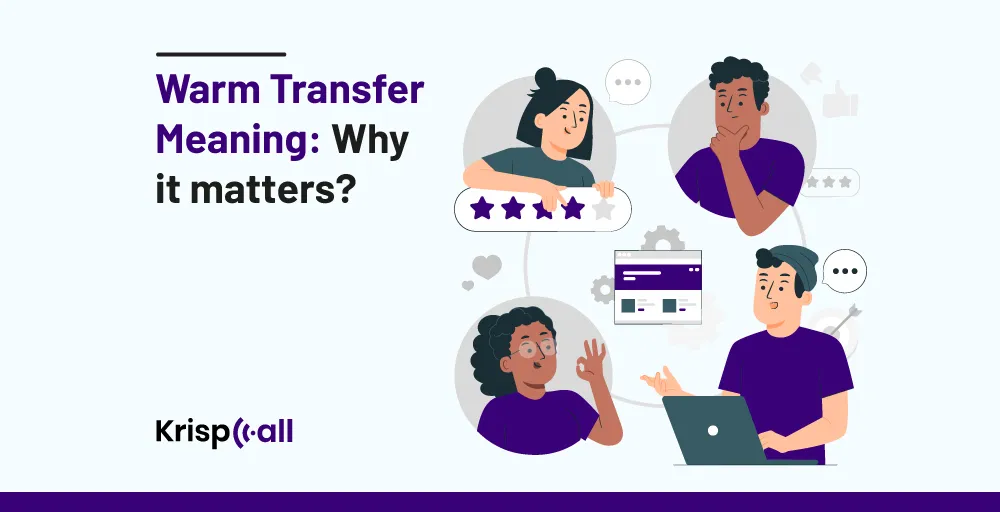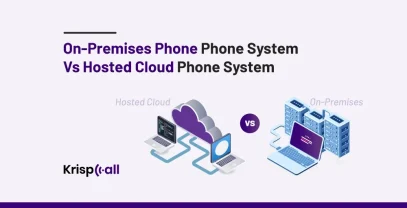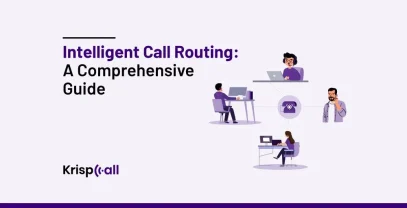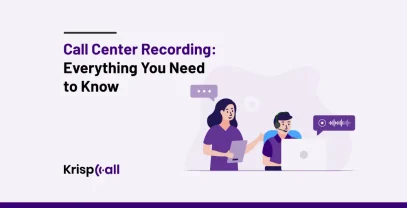Are long calls and unhappy😔 customers draining📉 your profits?
Warm transfers are the secret weapon⚔️ you’ve been missing.
But what exactly is warm transfer? Does it really help in handling customer inquiries and improve customer satisfaction?
Find out👀 in this blog post.
🔑KEY HIGHLIGHTS
- Warm transfers prevent customers from repeating themselves, ensuring a seamless customer experience.
- Efficient warm transfers lead to increased efficiency, productivity, and positive customer experiences for businesses.
- Warm transfers are recommended when expert help is needed, to expedite issue resolution or upon the caller’s request for a specific department or person.
- Cold transfers are common but may leave customers feeling ignored, while warm transfers offer a personalized solution, improving customer satisfaction.
- Features like CRM integration, Call routing, and unified communication platforms are improving the process of transferring calls.
Without further dues, let’s get started.⬇️
What is a warm transfer?
A warm transfer is a method of transferring a customer call from one agent to another in a smooth and informed way where the initial agent briefs the receiving agent on the customer’s issue and passes the relevant information.
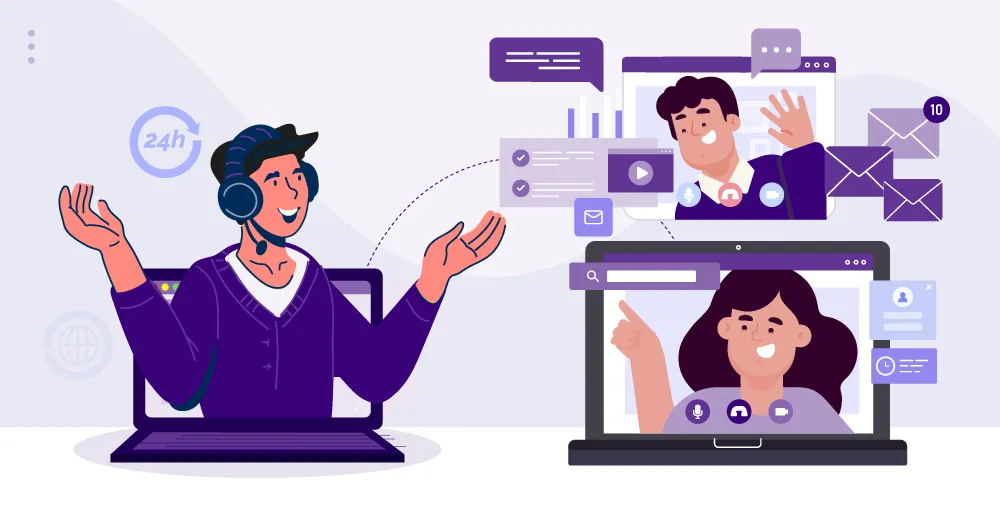
It is a customer-centric approach that eliminates the need for the caller to repeat themselves, ensuring a seamless and more efficient customer service experience.
Example of warm call transfer in a call center
Sarah, frustrated with her internet service, calls her provider. After describing the issue, the agent empathizes and explains, “To get you the fastest solution, I’d like to connect you with our senior technician, Mark. He’s familiar with this issue and I’ve already briefed him. Does that sound good?” Sarah agrees. Mark greets her warmly, acknowledging the briefing and diving right in to fix the problem, leaving Sarah feeling heard and valued.
This is the difference⚡ a warm transfer makes.
Warm transfer in a call center ensures a smooth transition avoiding repetition and frustration for the customer facilitating positive call center experiences.
What are the benefits of a warm transfer?
Warm transfer matters because it holds significant value for customers and businesses in a call center🎧. Customers feel heard and valued when they don’t have to repeat their concerns to multiple agents.
Additionally, when the customer’s query is efficiently handled through warm transfer, businesses benefit from increased✅ efficiency, productivity, and positive customer experiences.
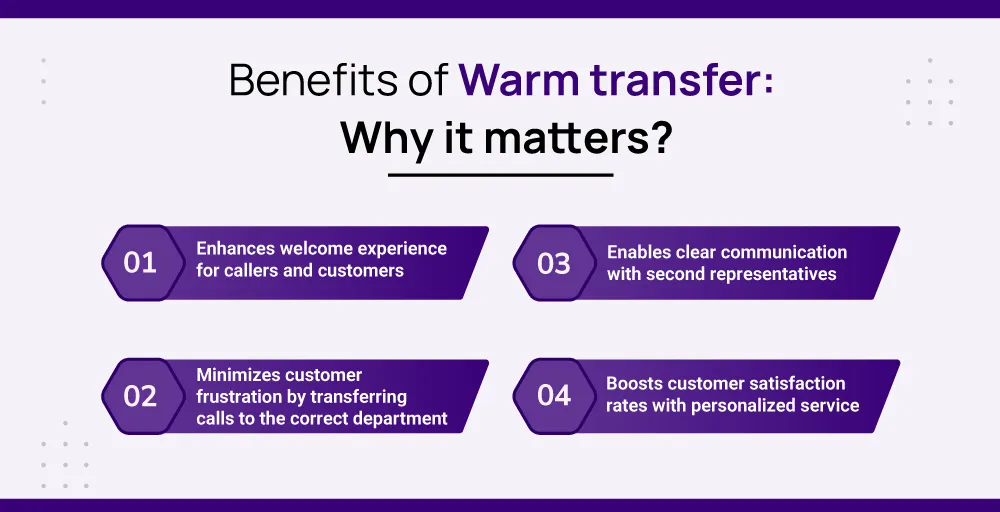
Here are a few more reasons why warm transfer matters:
Enhances welcome experience for callers and customers
Warm transfers avoid the impersonal “hold, please” scenario and instead, create a smooth transition that feels personalized and attentive.
This reduces initial anxiety and fosters a more positive🤗 perception of the call center right from the start.
This friendly welcome makes customers and the contact center feel valued and ready for a meaningful conversation.
Minimizes customer frustration by transferring calls to the correct department
By clearly communicating📢 the issue, warm transfers reduce the “wrong door” scenarios. Ensuring the right call center agent gets the call first saves customers from repeating their issues and wasting time. This leads to quicker solutions and satisfied customers who appreciate not being passed around needlessly.
Enables clear communication with second representatives
By sharing key details and context beforehand, warm transfers equip agents with the right pieces, enabling clear communication from the start.
This reduces misunderstandings, eliminates the need for repetition, and enables agents to focus🎯 on finding your customer’s solution.
Boosts customer satisfaction rates with personalized service
Warm transfers provide customers with the sense of being heard and valued, which they crave. Rather than feeling like just another number, they are introduced and briefed, showing attentiveness to their specific issue.
This personalized approach boosts their satisfaction, builds trust, and enhances the likelihood of their return for future needs, transforming one-time callers into loyal customers.
When to warm transfer a call?
A warm transfer is advisable in several scenarios✍, such as when the caller needs expert help, when transferring helps solve the issue faster, or when the caller asks for a specific department or person.
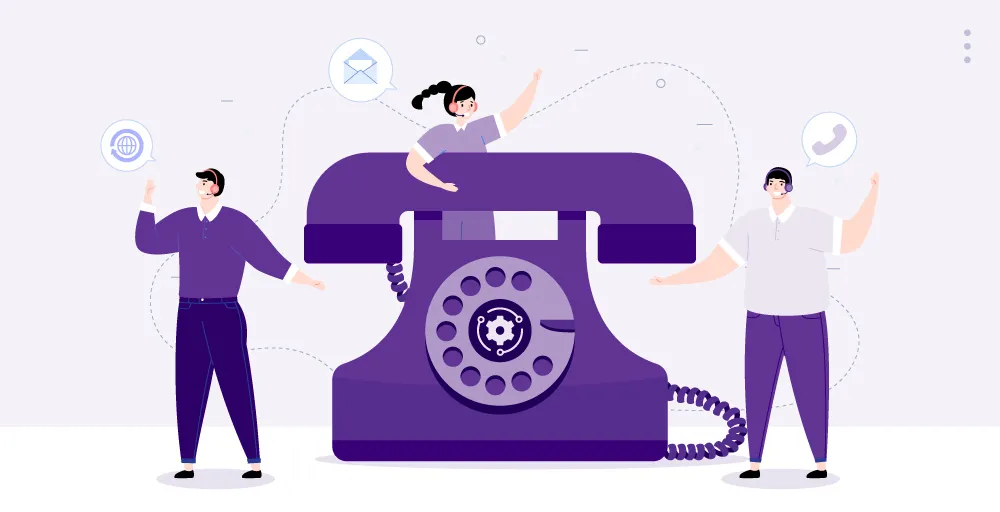
- When the caller needs expert help that your current skills cannot provide: If you find yourself unable to fully assist the caller due to the complexity🤯 of their issue or your limitations, consider a warm transfer. It ensures that the caller is connected to someone who can provide the necessary expertise to address their concerns effectively. Briefly summarize the issue and any troubleshooting steps you’ve taken to help the specialist hit the ground running.
- When transferring helps solve the issue faster: If you know that transferring the caller to a specific department or individual will expedite resolution then initiate a warm transfer. It minimizes the time⏳ the caller spends on hold or explaining their issue multiple times. Briefly explain the issue and any relevant context to the receiving agent for a quicker resolution.
- When the caller asks for a specific department or person: If the caller asks for a specific department or person, honor their request by initiating a warm transfer. Fulfilling their request demonstrates attentiveness and builds trust🤝. Introduce the caller and provide a brief overview of the situation to ensure a smooth handover.
7 Best Practices for Transferring Warm Calls
Here are the 7 best practices to ensure smooth warm transfers in your call center or contact center.
1. Obtain all necessary caller details
Before transferring a call, gather important details like the caller’s name, contact information, and a summary of their issue. This helps the next person they talk to be ready for a smooth transition.
2. Clearly communicate the transfer process
Explain the call transfer and process clearly, outlining why it’s necessary and who the caller will be speaking with. This builds trust and avoids confusion.
3. Seek permission before proceeding
Always ask for the caller’s permission before transferring. Respect their decision if they prefer to wait or speak with a new agent or someone else.
4. Double-check and confirm information with the caller
Verify all details like name, department, and issue summary with the caller to ensure accuracy and avoid misunderstandings.
5. Take ownership of any delays or inconveniences
If there are any delays or inconveniences during the transfer, take responsibility and apologize to the caller, demonstrating professionalism and commitment to customer satisfaction.
6. Reassure the caller about the transition
Provide reassurance to the caller that the transfer is being handled smoothly and that they will be connected to the appropriate representative shortly.
7. Confirm the caller’s connection with the receiving representative
Before ending the call, confirm that the caller has been successfully connected to the receiving customer service representative, ensuring that their needs will be addressed promptly and effectively.
Warm transfer Vs. Cold transfer: Which one is better?
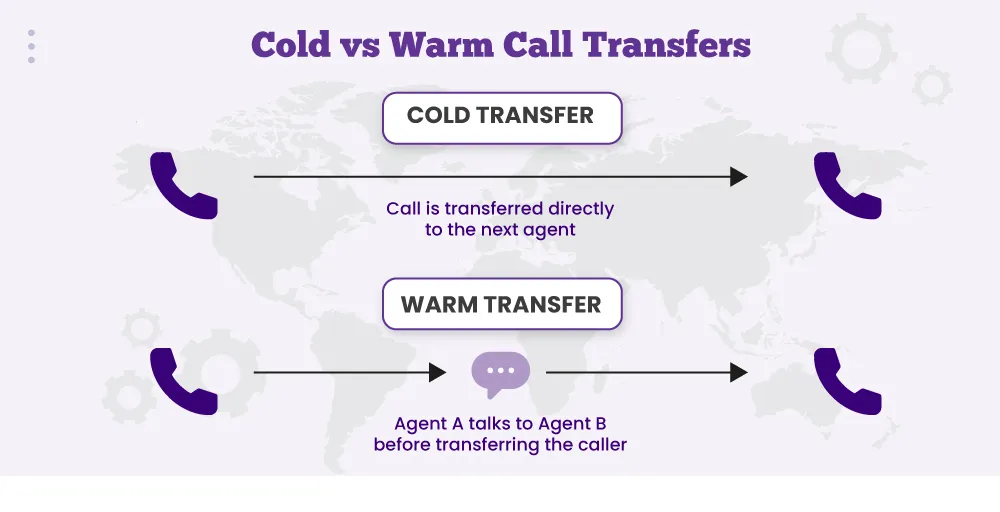
When it comes to customer calls, there are two main types of transfers: cold transfers🥶 and warm transfers.
Cold transfer, also called blind transfer, happens when a call is sent straight to another agent without any introduction or explanation.
For example, imagine a customer calling their utility provider to inquire about a billing issue. Instead of being connected to the billing department, their call is transferred blindly to the technical support team, leaving the customer confused and frustrated.
On the other side, warm transfers involve introducing the caller and explaining their issue to the next agent, making the switch smoother.
For example, a receptionist might warmly transfer a customer inquiring about a billing issue to the right department and quickly explain🗣️ the situation. In this scenario, the receptionist would say something like, “Hello, I have a customer on the line who has a question about their recent bill. I’ll transfer them to the billing department so they can assist you.”
Not all call transfers are alike. Cold transfers can frustrate customers because they might have to repeat themselves to different agents. In contrast, warm transfers make the customer experience better by sharing important information with the next agent.
Cold transfer calls are common in call centers, but they don’t always give the best service. Customers might feel ignored🙁 if they’re transferred without any heads-up.
But warm transferring shows a more personal way of helping customers. By transferring them to the right team member or department with the right info, agents can solve problems better and make customers happier😃.
Also, check out👀: Call Forwarding Vs Call Transfer: What are the differences
How today’s technology can help to warm transfer calls in a better way?
Today’s technology significantly improves the process of transferring calls whether they’re cold or warm transfers.
Features like CRM integration enable agents to quickly access customer information, enhancing assistance during transfers and reducing the likelihood of errors⚠️ and frustrations.
Smart call routing efficiently connects callers to the appropriate agent, minimizing transfers and enhancing satisfaction.
Additionally, unified communication platforms facilitate seamless information sharing among agents before transferring calls, ensuring a smooth experience for callers and improving overall operational efficiency💯.
To experience these advancements, consider trying KrispCall. With its innovative features and user-friendly interface, KrispCall is ready to elevate your call center operations to new heights.
Final Words
Warm transfers might seem like a basic feature but by prioritizing warm transfers over cold transfers, businesses can enhance customer satisfaction, streamline operations, and foster stronger customer relationships.
If your customer communications plan lacks the strategic incorporation of warm transfers, it’s high time to consider its integration for enhanced customer satisfaction and operational efficiency.
Try KrispCall today and see the difference😎 it can make in optimizing your call transfer process.
FAQ
When should I use a warm transfer instead of a cold transfer?
Warm transfers are recommended when the caller needs expert help, when transferring helps solve the issue faster, or when the caller requests to speak with a specific department or person. Using a warm transfer ensures that the caller’s needs are addressed efficiently and that they do not get transferred to the wrong department.
How can I initiate a warm transfer using my desk phone?
To initiate a warm transfer using your desk phone, first inform the caller that you will be transferring their call. Then, consult with the receiving agent to provide them with the necessary context before transferring the call. Once the receiving agent is prepared, transfer the call using the appropriate function on your desk phone.
How can I ensure a successful warm transfer?
For a successful warm call transfer, gather caller details, communicate the transfer process clearly, seek permission, confirm information, take responsibility for any delays, reassure the caller about the transition, and confirm the connection with the receiving representative before ending.

